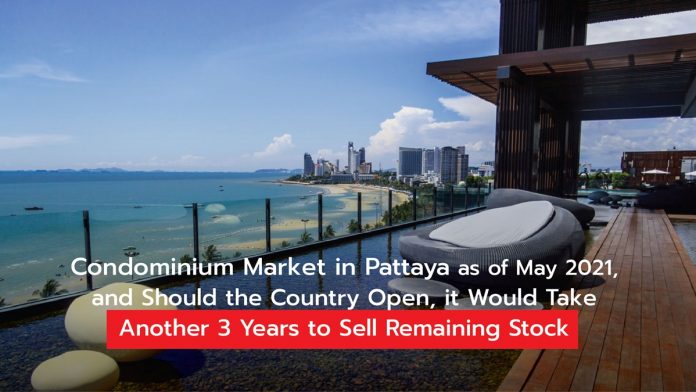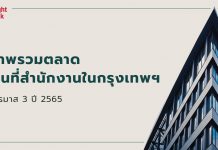Mr Nattha Kahapana, Deputy Managing Director and Head of Knight Frank Phuket Office, Knight Frank Thailand Co., Ltd., said, “The situation with the Covid-19 epidemic continues to spread until today. During this time, there has been no major purchasing power from foreign investors coming into the country. As for domestic investors, they have delayed their condominium purchases, opting to wait and see, which makes condo sales even more stagnant.

From January to the end of May, it was found that the number of new units sold was approximately 25 percent or 1,032 units, compared to 2020. Most of the buyers are Thai people from Bangkok who buy properties as their second homes; however, they are the only group and their purchasing power is declining. Moreover, aside from the epidemic situation, operators are concerned about the groups of people who bought condos to keep that are gradually releasing more second-hand condos into the market. As a result, stocks of condos that have been completed and available for sale remain in the market. Even with many promotions or reduced prices, this inventory does not move and it makes selling condominiums in Pattaya this year very difficult and challenging for developers.”
Supply
The cumulative supply of Pattaya condominiums from before 2010 until May 2021 totalled 118,026 units. During the first five months of 2021, no new condominiums have been launched for sale. According to a survey, most of the supply, or 44 per cent, is located in Jomtien. This is followed by Pratumnak Hill and Central Pattaya, accounting for 17 per cent and 10 per cent, respectively. South Pattaya and Wongamat make up 9 per cent and 6 per cent, respectively, while Na Jomtien and North Pattaya accounted for 8 per cent and 5 per cent, respectively. The Bang Saray area only comprises 1 per cent of the supply.


Demand
Before the Covid-19 epidemic, most of the buyers of condominiums in Pattaya were foreigners, especially Chinese investors. However, after the Covid-19 outbreak, the main group of buyers are currently Thai people who come from Bangkok. They purchase properties as their second homes, and as they currently comprise the only buyers in the market, the purchasing power in Pattaya has clearly diminished.
As of May 2021, the cumulative sales of condominiums in Pattaya was 98,998 units out of a total supply of 118,026 units, representing a total sales rate of 83.9 per cent. The sales rate increased by 0.9 per cent since the end of 2020. However, a market assessment and data survey revealed that the number of units sold in the first 5 months of 2021 was only 1,032 new units, or approximately 25 per cent of the number of units sold in 2020. This is largely because the main, foreign buyers have disappeared and still have not returned. In addition, the remaining numbers of Thai buyers have significantly declined.
As of May 2021, there are approximately 19,000 condominiums in Pattaya left for sale. It is estimated that, if there is no new supply, the remaining units will take another three years to sell out if the situation returns to normal.


The three areas with the most sales included Wongamat with the highest sales rate of 94 per cent, followed by North Pattaya and Central Pattaya with sales rates of 93 per cent and 88 per cent, respectively. The sales rate of Pratumnak Hill is comparable to the Central Pattaya area.
As for the Jomtien area, it contains the highest number of unsold units, at 7,474 units. This is because the area still has quite a lot of space to develop. Also, most new projects have been launched in this area. Some projects that have been launched for sale have been unable to continue; the developers have had to stop sales or sell their project to other investors who then adjusted the design and managed the project instead.

Selling Prices
As for the average selling price of condominiums in all areas of Pattaya as of May 2021, sea view condominiums had an average selling price of 111,039 baht per square metre, a 9.7 per cent decrease from 2020, which had an average selling price of 123,090 baht per square metre.
Condominiums with partial sea views had an average selling price of 69,154 baht per square metre, decreasing 13 per cent from 2020, which had an average selling price of 79,570 baht per square metre. Condominiums without a sea view had an average selling price of 66,921 baht per square metre, decreasing from 2020 by 13.2 per cent, which had a selling price of 77,116 baht per square metre.

Outlook
From surveying, it was found that there are still many units left for sale. This is due to the spread of Covid-19, which made foreigners unable to travel into the country. Moreover, Thai buyers have become more cautious in their spending. Although the production of vaccines will exceed 12 billion doses this year, which is enough to inoculate more than 75 per cent of the world’s population, in Thailand, vaccinations for the population remain limited.
The Thai economy during the second half of the year is expected to not improve as previously expected. Most developers who embark on projects in Pattaya are local investors, and they therefore chose to slow down the launches of projects as well as the development of vacant land. However, some large developers from Bangkok still chose to make investments, such as ICONSIAM that plans to invest in Na Jomtien as it sees an opportunity for future growth with the Eastern Economic Corridor (EEC) development plan that the government has championed.
In terms of tourism, the government has a pilot plan to open the country to vaccinated foreign tourists who can travel in a limited area. There is also a scheme to encourage Thai people to travel locally. However, the recovery of the Pattaya condominium market depends mainly on the tourism sector, and this may take 2 to 3 or more years to recover. Each country wants to revitalize its own economy first and then have its citizens travel to other countries; only then would inbound travel from foreign tourists resume.














